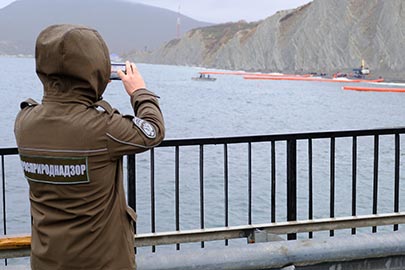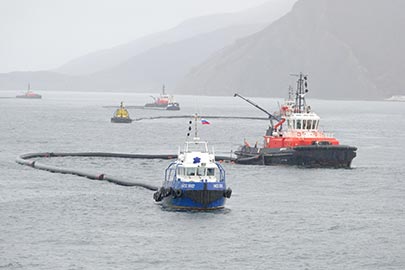 On 22 November 2022, a large-scale drill of permanent readiness of resources and equipment was conducted in the water area of the Maritime Port of Novorossiysk within Caspian Pipeline Consortium’s responsibility zone.
On 22 November 2022, a large-scale drill of permanent readiness of resources and equipment was conducted in the water area of the Maritime Port of Novorossiysk within Caspian Pipeline Consortium’s responsibility zone.
The drill scenario was to contain and eliminate an emergency oil spill that occurred as a result of destruction of two adjacent tanker tanks during the loading of an oil tanker from the Single Point Moorings (SPM-1).
The drill was based on the provisions of Federal Law #155-FZ of July 31, 1998 "On Inland Sea Waters, Territorial Sea and Contiguous Zone of the Russian Federation", and the findings issued to CPC-R by the Federal Transport Supervision Service (Rostransnadzor Southern Department) and other supervisory authorities.
 The function was a mandatory requirement prior to approval of the Plan to prevent and respond to oil and oil products spills (OSRP) at the Marine Terminal of Caspian Pipeline Consortium-R.
The function was a mandatory requirement prior to approval of the Plan to prevent and respond to oil and oil products spills (OSRP) at the Marine Terminal of Caspian Pipeline Consortium-R.
The drill objectives were:
- to practice interaction of CPC-R divisions when carrying out CPC-R cargo operations at CPC-R Marine Terminal in the water area of Novorossiysk Maritime Port;
- to practice arrangement of deployment and actions of the Commission for Prevention and Response to Emergencies and Fire Safety (CPREFS) and Emergency Operations Center (EOC) of CPC-R to contain and eliminate an oil spill when an emergency arises in the water area;
- to practice arrangement of deployment and interaction of resources and equipment engaged in performing the OSR Plan;
- to practice the scheme of communication and emergency warning system in carrying out efforts to respond to emergencies and mitigate their consequences, knowledge of radio call signs and channel numbers on VHF and VHF;
- to practice arrangement of interaction of CPC-R CPREFS via its dispatcher services and the ERG resources and equipment participating in the OSR actions.
- to check sufficiency and assess capacities of resources and equipment involved as per the OSR Plan to mitigate the consequences of accidents at CPC-R Marine Terminal;
- to practice arrangement of initial actions to contain oil product spill;
- CPC-R CPREFS Heads’ practice in managing subordinate resources and equipment during mitigation of consequences of sea accidents;
- to practice the process of deploying the booms and collecting the spilled oil;
- to practice arrangement of event documentation process;
- to demonstrate CPC-R readiness to work within the water area of the Maritime port of Novorossiysk.
About 200 people took part in the drill, including PERU staff and rescuers from Transneft-Service LLC - 155 rescuers.
In the course of practicing the set objectives and tasks, CPC-R dispatcher - using the Automated Emergency Warning System - communicated the information to the governmental regulatory and supervisory authorities and to the interacting organizations and entities. Then, the management bodies were assembled, CPC-R’s OSR Plan was put into effect, and the Emergency Operations Center (EOC) was formed.
According to the OSR Plan, a forecast of the oil slick spread was made based on the reconnaissance findings, taking into account the actual hydro-meteorological conditions. Based on the information received, the EOC developed a concept for the response to the oil spill.
Booms on board emergency response vessels were deployed in the direction of the drift of the oil slick. Floating tanks delivered from the Marine Terminal Small Boat Shelter (SBS) were used to collect the oil-water emulsion. Spilled oil was collected at various points by oil-gathering systems deployed on emergency response vessels in the respective operating area. In addition, skimmers and vacuum units were used to collect oil along the shoreline and the 9,500 cu.m multipurpose tank (MPT) was used to accumulate the collected oil-water mixture.
At the same time, gas analysis of the air environment and monitoring of oil pollution movement was performed in the area of the oil slick on a continuous basis by the regular equipment of the vessels involved.
In the course of the exercise, the schemes for organization and management of the organic emergency response means were checked, sufficiency of the facility emergency response staff and equipment and their compliance with the regulatory level specified in the Oil Spill Prevention and Response Plan were assessed.
The drill was observed by the commission consisting of representatives of regulatory and supervisory agencies - Russia’s MChS, Rosprirodnadzor, Novorossiysk Municipality Administration, Black Sea Ports Administration, Rostransnadzor and others.
On 2 December, 2022, Federal Agency of Marine and River Transport (Rosmorrechflot) issued its positive opinion on the drill prior to approving the Oil and Oil Product Petroleum Products Spill Prevention and Response Plan for CPC-R Marine Terminal.
CPC conducts at least 10 large-scale oil spill response and fire extinguishing drills annually. Large-scale exercises are conducted on a regular basis, allowing to assess the readiness of CPC pipeline operation teams, Security and dispatchers of the Consortium to emergencies. Thirteen scheduled drills were conducted in 2022 along the entire Tengiz-Novorossiysk crude pipeline route.
For information:
The CPC Pipeline System is one of CIS largest energy investment projects that involves foreign capital. The length of the Tengiz – Novorossiysk pipeline is 1,511 km. This route moves over two thirds of all Kazakhstan export oil along with crude from Russian fields including those in the Caspian region. CPC Marine Terminal is equipped with three Single Point Moorings (SPM), allowing tankers to be loaded safely at significant distance offshore, including in poor weather conditions
CPC Shareholders: Federal Agency for State Property Management represented by Transneft (trustee) – 24%, CPC Company – 7%, KazMunayGas – 19%; Kazakhstan Pipeline Ventures LLC – 1.75%, Chevron Caspian Pipeline Consortium Company – 15%, LUKARCO B.V. - 12.5%, Mobil Caspian Pipeline Company - 7.5%, Rosneft-Shell Caspian Ventures Limited - 7.5%, BG Overseas Holding Limited - 2%, Eni International N.A. N.V. - 2%, and Oryx Caspian Pipeline LLC – 1.75%.